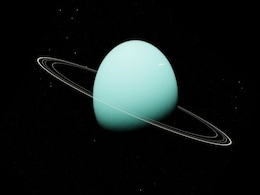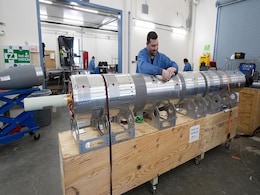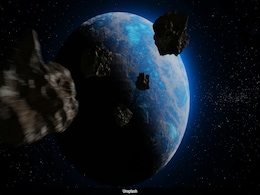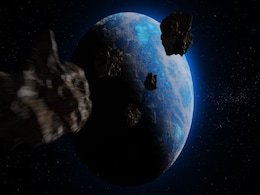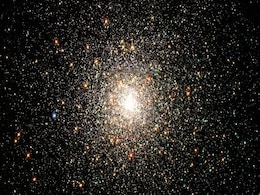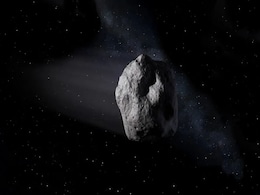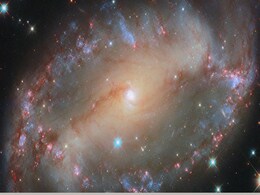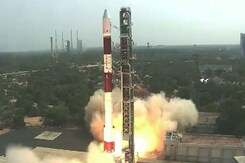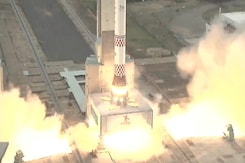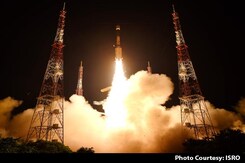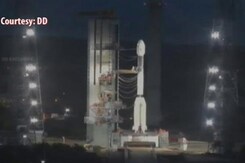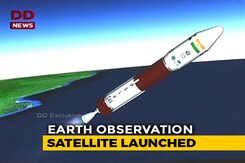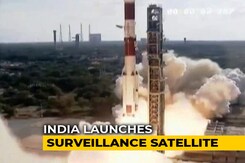Earth Observation
- All
- News
- Videos
- Web Stories
-

Scientists Finally Discover How Long a Day Lasts on Uranus
- Saturday April 12, 2025
- Written by Gadgets 360 Staff
Astronomers confirm Uranus’ rotation period using internal oscillation modeling for the first time. On Uranus, a day just lasts far longer. More precise rotational time observations of the gas giant should enable scientists to plan visits to investigate it. Unlike on Mars and Earth, savage windstorms make it far more difficult to identify the rot...
-
 www.gadgets360.com
www.gadgets360.com
-

JWST Captures Unseen Details of Exoplanets in HR 8799 and 51 Eridani Systems
- Thursday April 3, 2025
- Written by Gadgets 360 Staff
The James Webb Space Telescope (JWST) has captured groundbreaking images of exoplanets in the HR 8799 and 51 Eridani systems. By modifying its coronagraphs, astronomers allowed more starlight to pass through, revealing clearer planetary details. The study, published in The Astrophysical Journal Letters, highlights the first successful detection of ...
-
 www.gadgets360.com
www.gadgets360.com
-

NASA to Launch Three Rockets in Alaska to Study Auroral Substorms’ Impact
- Saturday March 29, 2025
- Written by Gadgets 360 Staff
NASA is conducting a rocket experiment from Poker Flat Research Range in Alaska. Three rockets will launch within a three-hour window to study how auroral substorms influence the Earth's upper atmosphere. Scientists will observe whether auroras drive vertical convection or if acoustic-buoyancy waves spread their energy over a wider region. Vapour t...
-
 www.gadgets360.com
www.gadgets360.com
-

Partial Solar Eclipse of March 2025: Satellite Images to Show Moon’s Shadow
- Saturday March 29, 2025
- Written by Gadgets 360 Staff
A partial solar eclipse will take place on March 29, 2025, visible across parts of Europe, Africa, and North America. The event will reach its peak in Nunavik, Canada, where 94% of the sun will be covered at sunrise. From space, weather satellites like GOES-16 and Himawari will capture images of the moon’s shadow. The International Space Station ...
-
 www.gadgets360.com
www.gadgets360.com
-

Solar Storm to Trigger Northern Lights in US: Visibility, Timing & Impact
- Thursday March 6, 2025
- Written by Gadgets 360 Staff
A solar storm is expected to reach Earth tonight, potentially creating auroras visible as far south as New York and Idaho. The Space Weather Prediction Center (SWPC) of NOAA forecasts a G1-class geomagnetic storm, with a possibility of stronger G2 conditions. This may lead to disruptions in GPS and radio signals. The best time to witness the northe...
-
 www.gadgets360.com
www.gadgets360.com
-

NASA Confirms Asteroid 2024 YR4 Will Not Hit Earth, Risk Reduced to Zero
- Friday February 28, 2025
- Written by Gadgets 360 Staff
NASA has reassured the public that asteroid 2024 YR4 no longer poses any threat to Earth. Initially, the asteroid had a 1-in-32 chance of impact, making it a Level 3 risk on the Torino Scale. However, new observations have reduced the probability to zero. The asteroid will make close flybys in 2028 and 2032, providing scientists with an opportunity...
-
 www.gadgets360.com
www.gadgets360.com
-

NASA Lowers Risk of Asteroid 2024 YR4 Impact
- Friday February 21, 2025
- Written by Gadgets 360 Staff
NASA has significantly lowered the risk of asteroid 2024 YR4 hitting Earth in 2032. Initial estimates placed the impact probability at 1 in 32, but updated calculations have reduced it to just 1 in 360 (0.28 percent). Experts believe the risk will continue to decline as more data is collected. Despite being the riskiest asteroid on NASA’s Sentry ...
-
 www.gadgets360.com
www.gadgets360.com
-

New Seismic Data Challenges Earth's Inner Core Structure, Reveals Surprising Findings
- Wednesday February 19, 2025
- Written by Gadgets 360 Staff
Recent seismic data from 121 earthquakes recorded over three decades challenges previous beliefs about Earth's inner core. Researchers from the University of Southern California discovered structural changes in the core, suggesting it may not be as solid as once thought. These anomalies, observed while studying the core's slowing rotation, could of...
-
 www.gadgets360.com
www.gadgets360.com
-

Telescope Captures "City-Killer" Asteroid, NASA Tracking Potential Threat
- Tuesday February 18, 2025
- Science | Edited by NDTV News Desk
A newly discovered asteroid has climbed to the top of NASA's impact risk list after fresh observations doubled its chances of striking Earth in 2032.
-
 www.ndtv.com
www.ndtv.com
-

James Webb Telescope to Study Potentially Hazardous Asteroid 2024 YR4
- Thursday February 13, 2025
- Written by Gadgets 360 Staff
Asteroid 2024 YR4, identified in December 2024, has a 2.3% chance of Earth impact in December 2032. Due to uncertainties in ground-based size estimates, JWST will conduct infrared observations in March and May to determine its true dimensions. The European Space Agency estimates its width at 55 metres, but it could be as large as 90 metres. The fin...
-
 www.gadgets360.com
www.gadgets360.com
-

Chorus Waves Found Far From Earth Raise Concerns for Space Exploration
- Tuesday January 28, 2025
- Written by Gadgets 360 Staff
Chorus waves, energetic electromagnetic bursts resembling bird chirps, have been detected 100,000 miles from Earth, far beyond their usual range. NASA's Magnetospheric Multiscale satellites observed these waves in a flatter region of Earth's magnetosphere, contradicting prior assumptions about their formation near strong magnetic gradients. The wav...
-
 www.gadgets360.com
www.gadgets360.com
-

T Tauri's Great Dimming: Astronomers Study Young Star's Potential Disappearance
- Monday January 27, 2025
- Written by Gadgets 360 Staff
The young star T Tauri, located 471 light-years from Earth, is experiencing a significant dimming event. The cause is a thick dust and gas disk blocking its light, with astronomers predicting it may disappear from view for up to a century. This event presents an opportunity for scientists to explore the chemical makeup of planet-forming regions wit...
-
 www.gadgets360.com
www.gadgets360.com
-

Study Reveals Earth's Small Asteroid Likely Originated from the Moon
- Monday January 27, 2025
- Written by Gadgets 360 Staff
Asteroid 2024 PT5, discovered near Earth in 2024, is suspected to be a fragment from the Moon’s surface. Researchers found its composition matches lunar rock samples, specifically silicate-rich materials, unlike any known asteroid. Analysis from NASA’s Center for Near Earth Object Studies confirmed it is a natural object, not human-made debris,...
-
 www.gadgets360.com
www.gadgets360.com
-

China’s Ceres-1 Rocket Successfully Deploys 5 Satellites for Weather and Remote Sensing
- Friday January 24, 2025
- Written by Gadgets 360 Staff
China's space industry continues to grow with the successful deployment of five satellites by the Ceres-1 rocket on 20 January. The payload included four Yunyao-1 meteorological satellites and the Jitianxing A-05 remote sensing satellite. This launch, conducted by Galactic Energy, marks a key milestone in China’s expanding commercial space sector...
-
 www.gadgets360.com
www.gadgets360.com
-

Hubble Telescope Observes Young Stars HOPS 150 and HOPS 153 in Orion Nebula
- Wednesday January 22, 2025
- Written by Gadgets 360 Staff
The Hubble Space Telescope has captured images of two young stars, HOPS 150 and HOPS 153, in the Orion Nebula, which is located about 1,300 light-years from Earth. The binary system HOPS 150 glows in bright golden red, while HOPS 153 emits a colorful jet. These stars are still in their early stages of development, feeding from their surrounding dus...
-
 www.gadgets360.com
www.gadgets360.com
-

Scientists Finally Discover How Long a Day Lasts on Uranus
- Saturday April 12, 2025
- Written by Gadgets 360 Staff
Astronomers confirm Uranus’ rotation period using internal oscillation modeling for the first time. On Uranus, a day just lasts far longer. More precise rotational time observations of the gas giant should enable scientists to plan visits to investigate it. Unlike on Mars and Earth, savage windstorms make it far more difficult to identify the rot...
-
 www.gadgets360.com
www.gadgets360.com
-

JWST Captures Unseen Details of Exoplanets in HR 8799 and 51 Eridani Systems
- Thursday April 3, 2025
- Written by Gadgets 360 Staff
The James Webb Space Telescope (JWST) has captured groundbreaking images of exoplanets in the HR 8799 and 51 Eridani systems. By modifying its coronagraphs, astronomers allowed more starlight to pass through, revealing clearer planetary details. The study, published in The Astrophysical Journal Letters, highlights the first successful detection of ...
-
 www.gadgets360.com
www.gadgets360.com
-

NASA to Launch Three Rockets in Alaska to Study Auroral Substorms’ Impact
- Saturday March 29, 2025
- Written by Gadgets 360 Staff
NASA is conducting a rocket experiment from Poker Flat Research Range in Alaska. Three rockets will launch within a three-hour window to study how auroral substorms influence the Earth's upper atmosphere. Scientists will observe whether auroras drive vertical convection or if acoustic-buoyancy waves spread their energy over a wider region. Vapour t...
-
 www.gadgets360.com
www.gadgets360.com
-

Partial Solar Eclipse of March 2025: Satellite Images to Show Moon’s Shadow
- Saturday March 29, 2025
- Written by Gadgets 360 Staff
A partial solar eclipse will take place on March 29, 2025, visible across parts of Europe, Africa, and North America. The event will reach its peak in Nunavik, Canada, where 94% of the sun will be covered at sunrise. From space, weather satellites like GOES-16 and Himawari will capture images of the moon’s shadow. The International Space Station ...
-
 www.gadgets360.com
www.gadgets360.com
-

Solar Storm to Trigger Northern Lights in US: Visibility, Timing & Impact
- Thursday March 6, 2025
- Written by Gadgets 360 Staff
A solar storm is expected to reach Earth tonight, potentially creating auroras visible as far south as New York and Idaho. The Space Weather Prediction Center (SWPC) of NOAA forecasts a G1-class geomagnetic storm, with a possibility of stronger G2 conditions. This may lead to disruptions in GPS and radio signals. The best time to witness the northe...
-
 www.gadgets360.com
www.gadgets360.com
-

NASA Confirms Asteroid 2024 YR4 Will Not Hit Earth, Risk Reduced to Zero
- Friday February 28, 2025
- Written by Gadgets 360 Staff
NASA has reassured the public that asteroid 2024 YR4 no longer poses any threat to Earth. Initially, the asteroid had a 1-in-32 chance of impact, making it a Level 3 risk on the Torino Scale. However, new observations have reduced the probability to zero. The asteroid will make close flybys in 2028 and 2032, providing scientists with an opportunity...
-
 www.gadgets360.com
www.gadgets360.com
-

NASA Lowers Risk of Asteroid 2024 YR4 Impact
- Friday February 21, 2025
- Written by Gadgets 360 Staff
NASA has significantly lowered the risk of asteroid 2024 YR4 hitting Earth in 2032. Initial estimates placed the impact probability at 1 in 32, but updated calculations have reduced it to just 1 in 360 (0.28 percent). Experts believe the risk will continue to decline as more data is collected. Despite being the riskiest asteroid on NASA’s Sentry ...
-
 www.gadgets360.com
www.gadgets360.com
-

New Seismic Data Challenges Earth's Inner Core Structure, Reveals Surprising Findings
- Wednesday February 19, 2025
- Written by Gadgets 360 Staff
Recent seismic data from 121 earthquakes recorded over three decades challenges previous beliefs about Earth's inner core. Researchers from the University of Southern California discovered structural changes in the core, suggesting it may not be as solid as once thought. These anomalies, observed while studying the core's slowing rotation, could of...
-
 www.gadgets360.com
www.gadgets360.com
-

Telescope Captures "City-Killer" Asteroid, NASA Tracking Potential Threat
- Tuesday February 18, 2025
- Science | Edited by NDTV News Desk
A newly discovered asteroid has climbed to the top of NASA's impact risk list after fresh observations doubled its chances of striking Earth in 2032.
-
 www.ndtv.com
www.ndtv.com
-

James Webb Telescope to Study Potentially Hazardous Asteroid 2024 YR4
- Thursday February 13, 2025
- Written by Gadgets 360 Staff
Asteroid 2024 YR4, identified in December 2024, has a 2.3% chance of Earth impact in December 2032. Due to uncertainties in ground-based size estimates, JWST will conduct infrared observations in March and May to determine its true dimensions. The European Space Agency estimates its width at 55 metres, but it could be as large as 90 metres. The fin...
-
 www.gadgets360.com
www.gadgets360.com
-

Chorus Waves Found Far From Earth Raise Concerns for Space Exploration
- Tuesday January 28, 2025
- Written by Gadgets 360 Staff
Chorus waves, energetic electromagnetic bursts resembling bird chirps, have been detected 100,000 miles from Earth, far beyond their usual range. NASA's Magnetospheric Multiscale satellites observed these waves in a flatter region of Earth's magnetosphere, contradicting prior assumptions about their formation near strong magnetic gradients. The wav...
-
 www.gadgets360.com
www.gadgets360.com
-

T Tauri's Great Dimming: Astronomers Study Young Star's Potential Disappearance
- Monday January 27, 2025
- Written by Gadgets 360 Staff
The young star T Tauri, located 471 light-years from Earth, is experiencing a significant dimming event. The cause is a thick dust and gas disk blocking its light, with astronomers predicting it may disappear from view for up to a century. This event presents an opportunity for scientists to explore the chemical makeup of planet-forming regions wit...
-
 www.gadgets360.com
www.gadgets360.com
-

Study Reveals Earth's Small Asteroid Likely Originated from the Moon
- Monday January 27, 2025
- Written by Gadgets 360 Staff
Asteroid 2024 PT5, discovered near Earth in 2024, is suspected to be a fragment from the Moon’s surface. Researchers found its composition matches lunar rock samples, specifically silicate-rich materials, unlike any known asteroid. Analysis from NASA’s Center for Near Earth Object Studies confirmed it is a natural object, not human-made debris,...
-
 www.gadgets360.com
www.gadgets360.com
-

China’s Ceres-1 Rocket Successfully Deploys 5 Satellites for Weather and Remote Sensing
- Friday January 24, 2025
- Written by Gadgets 360 Staff
China's space industry continues to grow with the successful deployment of five satellites by the Ceres-1 rocket on 20 January. The payload included four Yunyao-1 meteorological satellites and the Jitianxing A-05 remote sensing satellite. This launch, conducted by Galactic Energy, marks a key milestone in China’s expanding commercial space sector...
-
 www.gadgets360.com
www.gadgets360.com
-

Hubble Telescope Observes Young Stars HOPS 150 and HOPS 153 in Orion Nebula
- Wednesday January 22, 2025
- Written by Gadgets 360 Staff
The Hubble Space Telescope has captured images of two young stars, HOPS 150 and HOPS 153, in the Orion Nebula, which is located about 1,300 light-years from Earth. The binary system HOPS 150 glows in bright golden red, while HOPS 153 emits a colorful jet. These stars are still in their early stages of development, feeding from their surrounding dus...
-
 www.gadgets360.com
www.gadgets360.com

